An interview between Paul Hetherington and Hephzibah Rendle-Short in London on 23 October 2013. Hephzibah Rendle-Short reflects on her joint practices as a visual artist and a psychoanalyst, and discusses points of connection between the two.
Paul Hetherington: I was reading the emails you sent me, and I was also reading your book. I thought we could start by talking about the book and the project it documents.
Hephzibah: The book was a part of an exhibition. It was an invitation by Clare Hall, a Cambridge college. I took various elements of what I was doing as an artist and brought them together: working with the available space in the college and what I had been doing with stah-scopes in my studio. These are objects that enable a viewer to look back at old work in the form of a painted image and, in doing so, something of the future is produced as a digital image. Also, because I had a long-standing relationship with the college, they were interested in the painting I had done previously. The book is not a description, it’s not an account, and it’s not even a diagram. It’s a nodal point of these intersections.
In the exhibition space, I had both paintings from the 1980s and images in my stah-scopes. The stah-scopes actually weren’t in the show but were the objects through which images could be viewed. I think what surprised me was that the whole thing seemed to be precisely about looking—the idea of being looked at, the gaze, how we look, how I look, how I’m looked at.
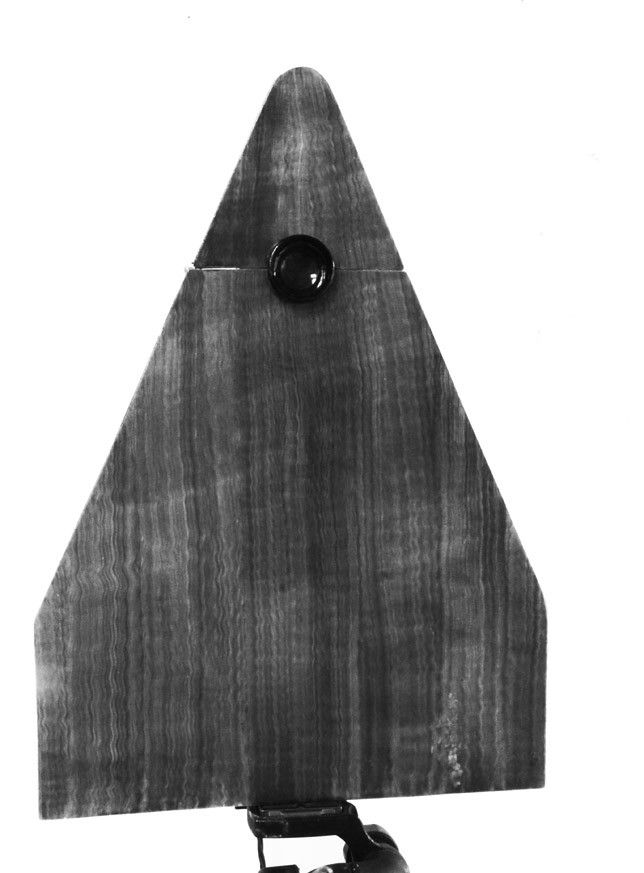
Paul: And in your book you’ve quoted from the forward to Robbe-Grillet’s 1965 edition of his novel Jealousy about how his ‘object has … neither function nor substance’; and that its ‘function and substance are absorbed by its optical nature’[i].
Hephzibah: Yes, it’s an excerpt from Roland Barthes.
Paul: What’s its significance?
Hephzibah: I bought a Robbe-Grillet novel, Jealousy in a little Penguin edition and I was struck by how he seemed to bracket off subjectivity. You never saw the subject. You never had a view of any person.
When I came to England from Australia there were studios run by Euan Uglow. There was the same bracketing off of subjectivity within those studios and attention to the object. It could be any sort of object, like a female form, or a fruit, or a head but it would be treated in the same way, point-to-point across the surface. There was always a kind of objectivity that involved empirically mapping what was in front of you.
And it seemed to cross over—what Roland Barthes was writing about Robbe-Grillet and what happened in those studios. Of course, they were coming from different traditions. On the one hand you have Robbe-Grillet and Roland Barthes coming from the continental philosophical tradition, and on the other hand you have Uglow coming from an English empirical tradition. I am caught in the middle of these two. I was interested in the continental traditions, particularly as they were expressed through psychoanalysis, and I was also an artist practising in England.
Paul: Can you say something about the organisation of the book and its sections such as ‘full length’, ‘back-lit’, ‘still-life’, ‘view x’ and so on?
Hephzibah: Oh, that’s playful. I was making stah-scopes in my studio which had come from another project. They proliferated in my studio and they became interesting—not because you look into and through them, but because they were strange objects that are slightly obsolete—you’re not quite sure what they are.
I was painting a still life of an apple, and I had a Victorian stand from my aunt and I enjoyed the installation that was accruing in my studio—and that became the subject.
Paul: How did that subject move into the images, the nudes?
Hephzibah: Well, they’re the slides that are in the slide viewers from the 1980s that I painted. The stah-scopes look strangely futuristic yet they reveal images from a few decades back. This reflected the influence of those studios which would map empirically the object in front of them. It was like a folding back in time—almost like a Möbius strip.
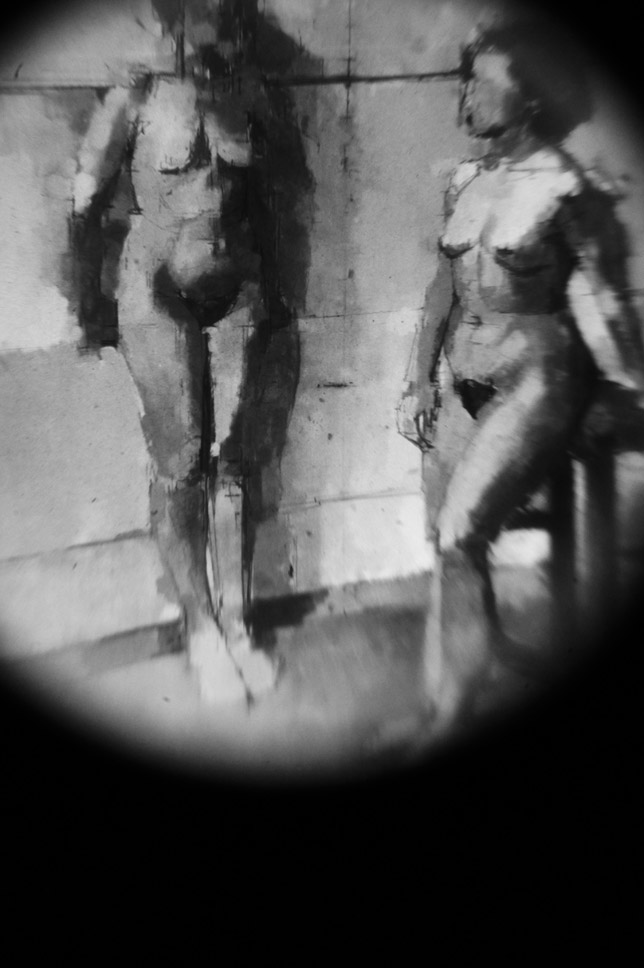
Paul: Is the exhibition partly about different ways of looking and seeing?
Hephzibah: No, I think it’s more about looking as such, or the gaze as such—to be looked at, to look.
Paul: What’s interesting about looking and the gaze?
Hephzibah: Well, I think then you move into psychoanalysis. Everybody has a drive and an object. The thing that you’re chasing all the time is the object and, I’ve discovered through psychoanalysis, mine seems to be through the looking. Hence putting myself in studios where I look nine to five.
Paul: Is that the impulse that led you into making art in the first place?
Hephzibah: I think so. It’s clearly not the voice, I have not been interested in the voice in the same way.
Paul: But in your work as a psychoanalyst, isn’t the voice a key …?
Hephzibah: Well, it’s in the register of the invocatory … that’s what I find really interesting—the scopic register of looking, and the invocatory register of hearing, and the cross-over between them. I see them on an axis and I find the relationship of the studio to the psychoanalytic setting really interesting. In one setting it’s about listening and you produce signifiers; in the other, it’s about looking and you produce marks.
Paul: Is one an analogue for the other?
Hephzibah: No, they’re different registers.
Paul: And do you think you can do both at the same time? Can you shift easily from one register to another?
Hephzibah: I think that’s my question. Where I’m practising psychoanalysis, setting up privately, I’ve painted the walls the grey of my studio … I know that seems a little thing but it’s quite important to me. I’m trying to map the intersection between the two things.
I think that’s why the Didi-Huberman book[ii] is so interesting. It’s a way of understanding the turn from looking into listening that Freud made. Freud spent three months in Salpêtrière with Charcot and it was all about the gaze and the hysterics who performed for the camera. Freud took that back to Vienna and put the hysteric on the couch, turning away from her, so it was only the voice.
Paul: Removing the gaze to enable the speaking?
Hephzibah: Yes, because according to Freud, the hysteric wants to be in the gaze of the other. Their desire is the desire of the other; they want to be in the place of the other’s desire. If you turn them; if you don’t allow that, then something else has to be mobilised. That’s why Freud’s ‘talking cure’ was so interesting.
Paul: By using the couch, and by situating himself behind …
Hephzibah: Yes. Although, he wasn’t unaware of what was happening in the bodies of his patients. He saw the excitement on the Rat Man’s face when he was talking about the rats—the suffering and the jouissance was written all over his face. But with Freud’s method there was no fixity in the gaze as there was in the traditions and conventions attending to the origins of psychoanalysis.
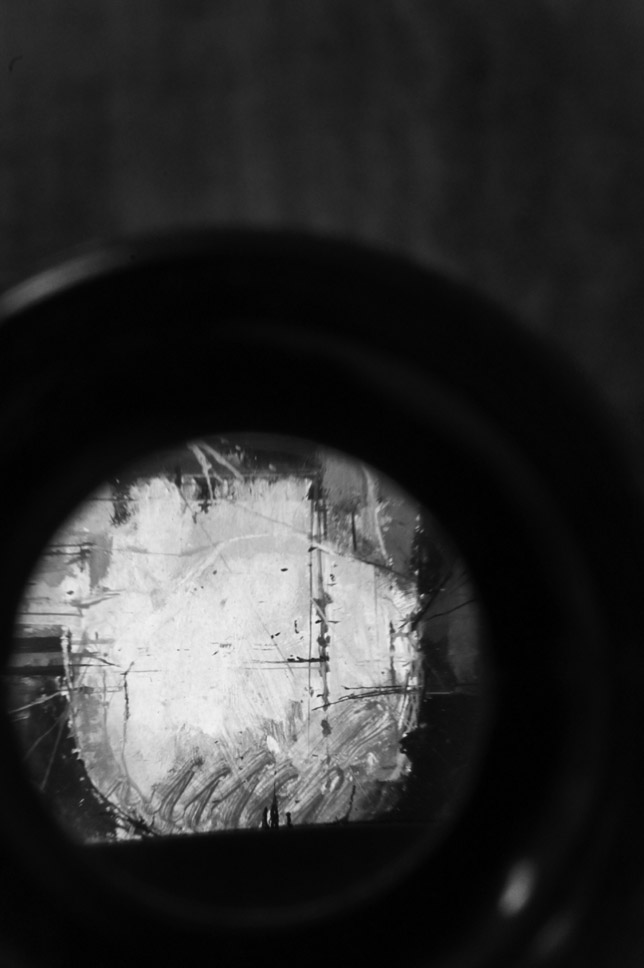
Paul: You moved from practising as an artist into psychoanalysis. What was that move?
Hephzibah: There’s something very compelling about psychoanalysis. I’m curious about the way people think and the way they construct their worlds—which, in turn, reflects on the way I think. It’s an attention to relationships with the world, which you could say isn’t that far from Roland Barthes’ writing about Robbe-Grillet’s attention to the things in the world.
Paul: In some of the commentary on Robbe-Grillet’s work there’s a sense in which the disposition of the detail in his sentences is significant. He says, for example: ‘on the kitchen table there are three thin slices of ham laid across a white plate’. He’s giving us the disposition of the objects he’s describing, and it’s almost as if we might understand them as artefacts.
Hephzibah: What does disposition mean?
Paul: I’m just using it in the sense of the way they’re disposed …
Hephzibah: Positioned?
Paul: Yes.
Hephzibah: I’m putting a hyphen between the prefix ‘dis’ and ‘position’ in my mind.
The positioning in Robbe-Grillet’s work allows a sense of precise measurement—which is what we were doing in the studios: measuring … so, in my picture of the apple, for example, the little marks on my picture are measurement marks, and that’s the way I would paint the painting. They are little measurement marks trying to find a way across the surface in the same way that the ham lies across the plate; the way it positions on the plate. It’s not food for anybody in particular; it’s rather points in space.
I don’t know what ‘dis’ means though. I think somebody’s disposition is their attitude towards something which seems much more on the side of an imaginary sense of something—like they might have an angry disposition or a happy disposition, which seems much more imaginary. So I would argue that what I’m looking for is something structural; something about position, whereas disposition is precisely the opposite. It is something about the imaginary affect. I think Robbe-Grillet denies disposition and embellishes position.
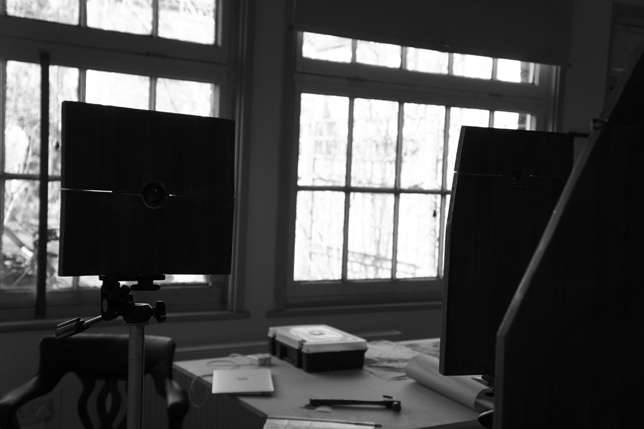
Paul: Does that mean, even though it’s language and words, that Robbe-Grillet’s writing is close to what you’re trying to do in your art?
Hephzibah: Yes, I think so. I do think so.
Paul: Because it’s a form of looking?
Hephzibah: A form of looking, and reducing it down to something structural—even to the point where the woman is reduced to a letter: A. Which is why I used view X, view Y and view Z to reduce it down. And that’s where the playfulness comes in because stah-scopes look slightly anthropomorphic. They look like they’ve got character but at the same time I’m saying, no, they’re just X, Y and Z. I’m playing precisely between position and disposition.
Paul: What about when you say they look human? The nudes are…
Hephzibah: Human.
Paul: Well, they’re a representation of humanity.
Hephzibah: But the approach in painting them wasn’t about character or about disposition or about … it was more about the structure of the figure in space …
Paul: Some people have criticised Robbe-Grillet’s fiction for being too cold and analytical; and too objective. They have suggested that he ought to have been more engaged and that his writing often moves away from any ethical or moral responsibility—what we might call a responsible human engagement—with tricky, difficult and important subjects?
Hephzibah: I would say ethics isn’t about empathy. I’d say that ethics is about something much more symbolic and is—I would be with Lacan on this—about desire, which is a symbolic curiosity for knowledge. So it’s on the side of a looking for knowledge rather than … how did somebody say it? … a humanistic pity.
Paul: Can you say more?
Hephzibah: This is psychoanalysis again. On the one hand you’ve got the imaginary register and on the other hand you’ve got the symbolic. The imaginary register is precisely a kind of humanistic pity, or empathy; someone’s belief that they can project into another, as if they know what another thinks. Ethics is on the side of the desire of the other’s alterity; the not-knowing what the other is. It’s not that there shouldn’t be compassion or kindness, but there shouldn’t be an assumption that ‘we’re in this shared thing together’. I think it’s much more on the side of ‘we’re not in this shared thing together at all’, you know?
Paul: And can you connect that back to your art?
Hephzibah: My understanding, or my psychoanalytic insights, have been growing and accruing so I look at my own work through that framework. I try to find a thread through it that’s meaningful; a logic—my own logic—that started when I was in my 20s. It’s retroactively thinking, ‘okay, so this is the logic that I’m using. What do I do with it now?’
I think about five or six years ago I felt I couldn’t take my painting any further. I did a PhD and started looking at psychoanalysis. And I’ve realised it’s not the end of the road; it was a stepping stone in another road.
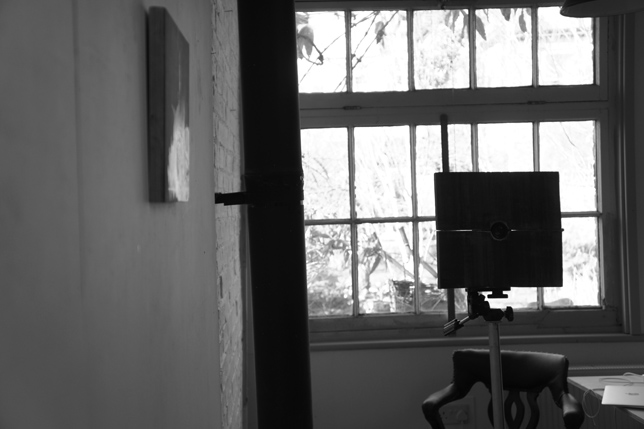
Paul: It’s always an interesting question about creative artists and their interest in knowledge and research. There’s often an idea that artists work intuitively, and to some extent unconsciously, but you seemed to have taken a path that’s about explicitly increasing your knowledge and bringing that knowledge back into artistic practice.
Hephzibah: I think so. I think people are just different and, being quite neurotic myself, I’ve got a desire for knowledge. I’ve always had a desire for knowledge … I’ll never know but it’s what keeps me questioning. It’s my question.
Paul: When you say you’ll never know … ?
Hephzibah: Well, if I know, I’ll die—because that’s precisely the structure of desire: that you keep looking for something.
Paul: Is desire what drives art?
Hephzibah: I don’t know. I think different people make art for different reasons. Did you listen to the Reith Lecture by Grayson Perry?
Paul: No.
Hephzibah: You’d get it on iTunes. You know they’ve got the series of Reith Lectures that happen every year?
Paul: Yes.
Hephzibah: This year [2013] it’s by Grayson Perry. He was talking about beating the bounds of the contemporary art world.[iii] It was really good. I didn’t agree with it all but it is worth listening to if you’ve got an hour. He was talking about what contemporary art was; how do you know whether it’s art or not.
Oh, I know what I don’t agree with. He was saying that art is only art if you can read it; if it produces a kind of an unknown question. I think you encounter it and it does something—much more akin to the Roland Barthes’ Punctum idea—whereas he was much more from the Studium side of things.
Paul: So if art is an encounter, what is it an encounter with?
Hephzibah: Well, I would say it’s an encounter with a not-knowing or a strangeness. But then I think of some of the things in the Freud Museum—that golden sculpture there, for example. That was not an encounter for me. I found that incredibly ugly. So it has to have a material quality as well, and that could be words in a poem or the material quality of an object. Maybe that’s why it’s so subjective.
Paul: Do the significant encounters depend very much on both parties in the encounter, the artwork and the person who’s looking, watching, engaging in it?
Hephzibah: Yes.
Paul: For example, the Wolf Man’s drawing of his…
Hephzibah: Beautiful, yes. Dream.
Paul: … dream with the five wolves sitting on the tree…
Hephzibah: Six or seven …
Paul: … six or seven wolves sitting on the tree. What do you find moving about that?
Hephzibah: Well, I think now it’s precisely the five and the six and the seven. The sense it can't be fixed. But I don’t really see that as a separate artwork, do you? It’s part of something so much bigger, to do with the case study.
Paul: I love the quality of dream those works have.
Hephzibah: A friend of mine told me a story yesterday about his dream when he was three and he dreamt …. His father loved mountains and kept images of mountains and looked at them in books, was quite obsessed by mountains; and this three year old had a dream of a mountain, he dreamt a mountain, and he was telling his analyst that he sat with his father and his father was trying to find his dream in a book, but he couldn’t find it. He couldn’t find it. It was brilliant. I think that’s such a beautiful story.
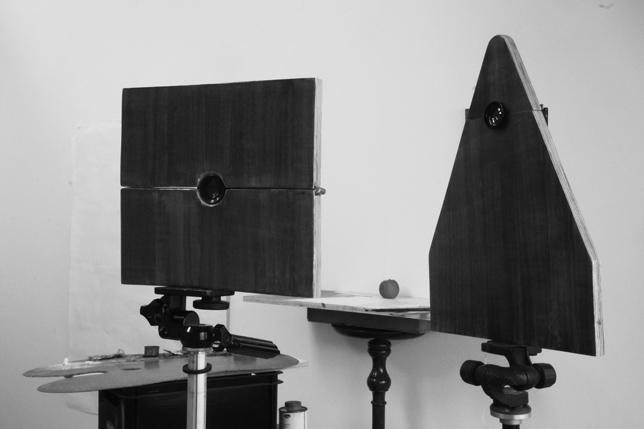
*
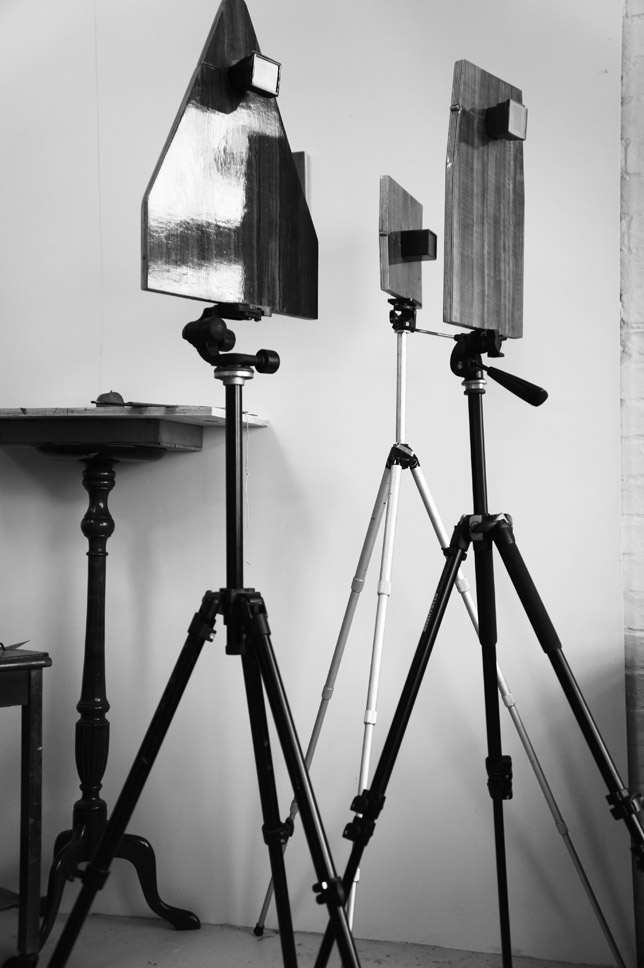
Paul: Have you just set up your studio again?
Hephzibah: Yes, I have … in London in Peckham. I go there twice a week if I can.
Paul: Are you making art?
Hephzibah: A few drawings. But I don’t really know what I’m doing.
Paul: That’s often the way with art isn’t it?
Hephzibah: It feels fine because I don’t have anybody looking down my … breathing down my neck. I just have to try and see if I can make work.
Paul: What’s interesting about your book to me is that you’ve got those early works which are quite beautiful—delicate images of nudes—seen through an optical device. They’re both distanced and yet brought close up in a strangely ambivalent sort of modality. Are you doing anything more with human figures …?
Hephzibah: No.
Paul: What are you sketching?
Hephzibah: I’m drawing the stah-scopes. I’m folding back on them, using different materials—using tracing paper and transparency; thinking of transparency as something to work with.
Paul: Another inflection of ways of looking?
Hephzibah: Exactly. I had a dream and … I’m drawing the thing in the dream, now that I come to think of it, which was like a kind of stah-scope but it wasn’t a stah-scope. It was more like the old-fashioned cameras in the Didi-Huberman book. A painter who I don’t particularly like, who doesn’t like my work, was holding an object, a camera, but not looking through it. The camera was just looking at the space and there was a painting of a tapestry fabric where the paint looked like woven tapestry. There was a material quality to the painting. So I’m drawing this camera which was like the stah-scopes, but not.

Paul: You mentioned early photography in reference to that book about Charcot. The early images that were made of hysterical patients?
Hephzibah: Yes …
Paul: … with equipment that sounds like your camera in the dream?
Hephzibah: Yes, I am interested. They’re quite theatrical.
Paul: Which, the cameras or the ..?
Hephzibah: The Charcot … because the patients had to hold those poses. It had to be quite theatrical.
Paul: They became their poses—which are emblematic of themselves, in a way. Are they already an idea of something rather than the thing itself?
Hephzibah: I think that’s precisely the point in Didi-Huberman’s book. They were caught in a relationship together. If the hysterics didn’t perform hysterically then they would be put in with the insane, which was pretty ghastly. They had to perform very well. You begin to wonder how much was it performance and how much it was true.
Paul: So, to some extent, these images of the hysterics may be a performance in the context of their institutionalisation in the sanatoria?
Hephzibah: Yes. Charcot was the master but actually the hysterics mastered him. He got what he wanted and it was a self-fulfilling prophecy. It was the mirror, precisely. The slippery sands of the mirror register.
Paul: Go on.
Hephzibah: Well, that there was nothing pinning anything down because it was on demand. Charcot would demand postures from the hysterics, the hysterics would provide them, and the more flamboyant the better. They would escalate and proliferate into the images that were produced and there was nothing holding it symbolically—it was just a proliferation of images.
Paul: Which influenced Freud and psychoanalysis? So, even the beginnings of psychoanalysis, or the early days of it, were inflected by the drama of fiction? Or was it not fiction; was it something else?
Hephzibah: It’s interesting because Freud so holds onto science, doesn’t he? You know it’s scientific but these case studies are almost literature. You become aware that it’s all fiction. In fact Freud says that at the end of the case on Schreber. He says, well, Schreber could write down these delusions and then he says, maybe psychoanalysis itself is a big delusion. Lacan picks up on that idea: that we all write stories … things are written and the truth is in the unconscious rather than in an empirical truth.
You can't get at the truth; you can only produce more stories. An interpretation in an analysis—you only know it’s worked if it can produce more material. It’s about producing more stories, if you like, which, if you think back to the Robbe-Grillet, or painting in the life rooms, you’re trying to pin down the structure of something.

Paul: And don’t you think Robbe-Grillet’s insistence on the position of particularities and detail, and his nuancing of that, creates, as well as a sense of particularity, a sense of ambiguity; a not-knowing?
Hephzibah: Yes, and if I remember in Jealousy, it’s almost like looking through the blinds? You keep getting a sense of something from lots of different points of view. It’s as if you can't actually fix something down and it is very ambiguous. And the smear of the squashed insects, do you remember?
Paul: Vaguely.
Hephzibah: A smear as if a mark … like that is what you can be sure of … a sort of surplus.
Paul: Is that one of the issues with modern art—going back to that question about art and what painters and artists are doing. Do we often have trouble deciding what is valuable as art, or what is a genuine article, unless we know that something has been defined as ‘art’, or genuine, or whatever? In other words, unless there’s a metanarrative or a story or a context which gathers in a particular object and says ‘this has a place’, it can be very difficult to make judgments.
Hephzibah: I find that fascinating, and if you go back to the wolves from the Wolf Man—that painting—if you read the case study, there’s a window frame. So there is a kind of symbolic framing.
If things aren’t framed, then what is art? Where are the boundaries? There are no limits and then you are into that psychotic mirroring. It’s interesting that Grayson Perry’s lecture was about beating the bounds. In England the Church of England has parishes and there was a kind of a ritual of beating the bounds, so you’d literally walk around the boundary and at particular points whip the youngest child so that they remembered on their body where the edges were. He used this as a metaphor for his lecture. Whenever he came to a point that was important—it must have been very theatrical in his tutu and his glitter—you could hear him whipping.
Paul: But how would you respond to an artist who might say, ‘why do we need boundaries; they’re restrictive and repressive’, and so on?
Hephzibah: I suppose it depends what we mean by boundary. Maybe it’s something about being mindful that there are boundaries but not having them as persecutory. Maybe it’s how they perform, how they function.
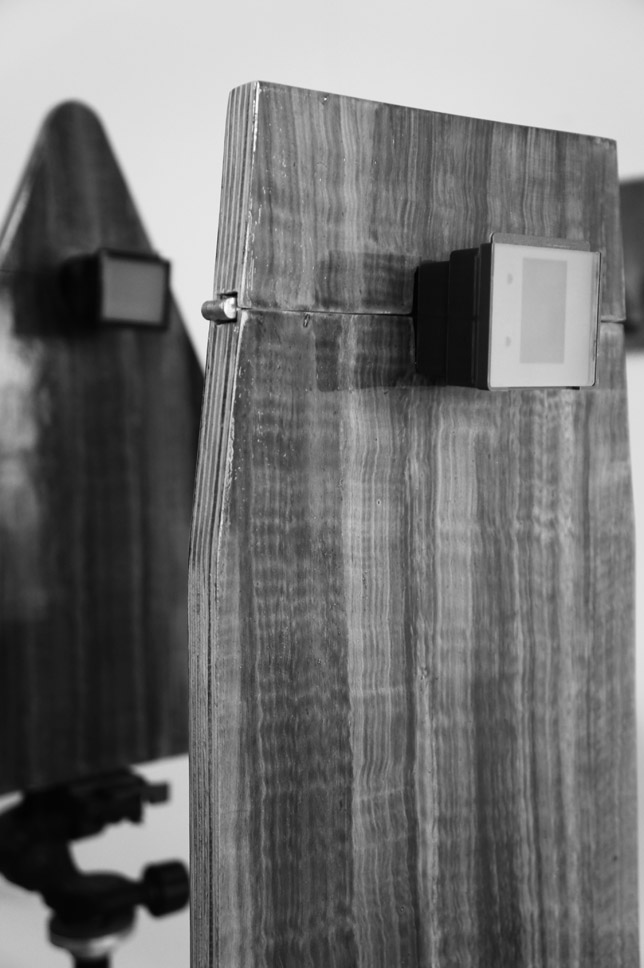
Paul: Are some boundaries providing what one might call a definition?
Hephzibah: Yes.
Paul: Yet if some art works sit in an indeterminate space, perhaps this can be equally challenging and interesting? If there’s just indeterminacy or irresolution or ambiguity can that be thrillingly about not-knowing?
Hephzibah: Don’t you think that’s kind of disingenuous …
Paul: Is it?
Hephzibah: Well, thinking that you can be in a completely ambiguous, indeterminate space. I would argue that the artists who really utilise that space—for example, John Cage—know very well what they are doing. Cage was exploring an indeterminacy within the bounds of what he knew.
Paul: The deep tradition of music and of performance?
Hephzibah: Yes, and of Zen Buddhism.
Paul: Which is one of the reasons it’s so interesting.
Hephzibah: Yes. And another thing to think about is Outsider art. There was a very interesting show at the Wellcome Trust—of Japanese Outsider art, and it was beautiful. It was the work of people suffering from psychosis or autism and it showed the way they would work with materials to make objects in a very repetitive and very urgent way.
Paul: Art’s often crossing the boundaries between what’s inside and outside, isn’t it?
Hephzibah: The beautiful, amazing work by these people was put within the Wellcome Trust, which is definitely an Insider institution. To me it showed the boundary, it didn’t show anything sitting between the two. I don’t think art does, I think art is very institutionalised.
Paul: So when you get Van Gogh not being able to sell his works and doing something that at the time is radical, is that an institutionalised activity?
Hephzibah: No, not for Van Gogh at the time he was making it. But for Van Gogh now as we look at it, yes.
Paul: Well, he’s become an institution.
Hephzibah: Yes, exactly. You could argue he was precisely one of these Outsider artists, who have now become Insider.
Paul: How can art matter to a lot of people who are sitting within the institutions; who are within the boundaries of convention and so on, if a lot of it’s been made outside of that? Or are the people within the boundaries actually craving what the outside offers?
Hephzibah: I was talking to a friend who went to the Venice Biennale and apparently this year there’s quite a lot of Outsider art, and she was saying how she has a feeling that the art world is so disenchanted by work which is regurgitated and that just tries to be sensational. They’re craving something true; or something less knowing of itself.
Paul: Less self-consciously contemporary and avant-garde?
Hephzibah: Yes, and I don’t want to use the phrase ‘more authentic’ because I don’t think that’s helpful, but … less knowing. I think there’s a real turn.
Paul: Is that something you feel in your own artistic practice?
Hephzibah: No because I’m not an Outsider. You could say rather I am duped by the Institution. But I think that’s why I’m interested in psychoanalysis.
Paul: Because?
Hephzibah: Because it is a space to incorporate what’s outside. It sets up the boundaries, as in the setting, the theatricality of it. What is produced in there, I think, has the potential of being outside making it have the logic of the Möbius strip.
Paul: Can you bring those insights into the outside into your institutionalised practice?
Hephzibah: Maybe that’s what I find interesting. I don’t know …
Paul: Is the challenge partly a way of finding an appropriate frame for the outside?
Hephzibah: Yes, or maybe I’m so institutionalised because I’m so grounded within that, in the symbolic world. Maybe it’s about allowing something else to happen within the studio.
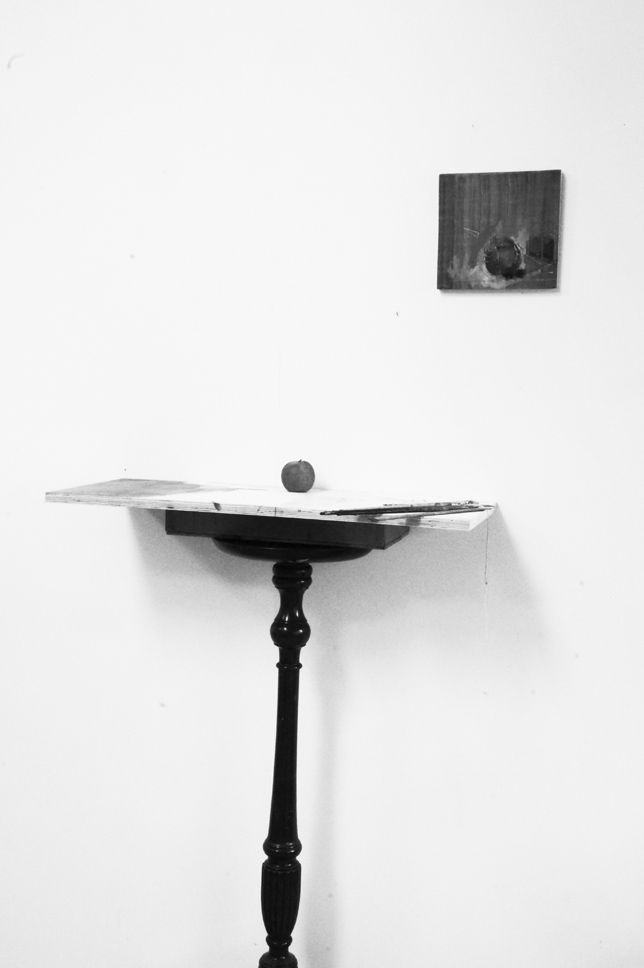
[i] Roland Barthes 1965 ‘Objective Literature: Alain Robbe-Grillet’, in Two Novels by Robbe-Grillet: Jealousy and In the Labyrinth, transl Richard Howard, New York, Grove Press, 11-25, 14
[ii] Georges Didi-Huberman 2003 Invention Of Hysteria: Charcot and the Photographic Iconography of the Salpêtrière, transl Alisa Hartz, Cambridge: MIT Press
[iii] A transcript of this lecture is available at http://downloads.bbc.co.uk/radio4/transcripts/reith-lecture2-liverpool.pdf